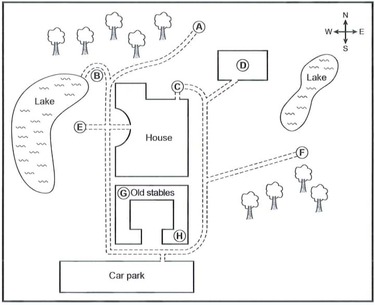Cambridge IELTS 19 - Listening Test 1 With Practice Test, Answers And Explanation
Luyện tập đề IELTS Online Test Cambridge IELTS 19 - Listening Test 1 được lấy từ cuốn sách Cambridge IELTS 19 với trải nghiệm thi IELTS trên máy và giải thích đáp án chi tiết bằng Linearthinking, kèm answer key và list từ vựng IELTS cần học trong bài đọc.
Section
👂️ Bài nghe section 1
The park
Area:
hectares1Habitats: wetland, grassland and woodland
Wetland: lakes, ponds and a
2Wildlife includes birds, insects and animals
Subjects studied in educational visits include
Science: Children look at
about plants, etc.3Geography: includes learning to use a
and compass4History: changes in land use
Leisure and tourism: mostly concentrates on the park's
.5Music: Children make
with natural materials, and experiment with rhythm and speed.6
Benefits of outdoor educational visits
They give children a feeling of
that they may not have elsewhere.7Children learn new
and gain self-confidence.8
Practical issues
Cost per child: £
9Adults, such as
, free10
❓ Tapescript section 1
🔥 Đáp án & giải thích section 1
Giải thích chi tiết
Hello Dolbie 🤩 Cùng chinh phục câu hỏi này nhé 😁
🎯 Xác định loại từ cần điền: Số đếm (diện tích của công viên)
▶️ Thông tin cần nghe ở: "Altogether the park covers 170 acres, that’s 69 hectares."
☺️ Cùng xem giải thích nhé: Bài nghe đã trực tiếp đưa ra thông tin về diện tích của công viên là 69 hectares.
✅ Đáp án đúng: 69
Section
👂️ Bài nghe section 2

❓ Tapescript section 2
🔥 Đáp án & giải thích section 2
Giải thích chi tiết
Hello Dolbie 🤩 Cùng chinh phục câu hỏi này nhé 😁
🌱 Đọc hiểu câu hỏi: During the visit to Malatte, in France, members especially enjoyed(Trong chuyến thăm Malatte, Pháp, các thành viên đặc biệt thích thú với điều gì?)
→ Ở đây, ta cần tìm xem hoạt động nào được nhấn mạnh là được yêu thích nhất trong chuyến đi. Các từ khóa quan trọng là "especially enjoyed" (đặc biệt thích) và "visit to Malatte" (chuyến đi đến Malatte).
📌 Từ khóa có thể được paraphrase:
"especially enjoyed" → "the real highlight" (điểm nhấn thực sự)
"visit to Malatte" → có thể đề cập đến những hoạt động được tổ chức ở đó
Section
👂️ Bài nghe section 3
Use of local products
Reduction in unnecessary packaging
Gluten-free and lactose-free food
Use of branded products related to celebrity chefs
Development of 'ghost kitchens' for takeaway food
Use of mushrooms for common health concerns
❓ Tapescript section 3
🔥 Đáp án & giải thích section 3
Giải thích chi tiết
Hello Dolbie 🤩 Cùng chinh phục câu hỏi này nhé 😁
🌱 Đọc hiểu câu hỏi
Which TWO things did Colin find most satisfying about his bread reuse project? (Colin cảm thấy điều gì hài lòng nhất về dự án tái sử dụng bánh mì của mình?)
→ Từ khóa quan trọng: Colin - satisfying - bread reuse project → Các đáp án đề cập đến những yếu tố khác nhau của dự án: nhận được sự ủng hộ, giảm lãng phí, khắc phục vấn đề, thử nghiệm thiết kế, học cách dùng in 3D. → Vì vậy, khi nghe, em cần chú ý đến cảm xúc của Colin (ví dụ: "really pleased", "satisfying", "great feeling").
▶️ Bắt đầu nghe ở:
Section
👂️ Bài nghe section 4
Ceide Fields
an important Neolithic archaeological site in the northwest of Ireland
Discover
In the 1930s, a local teacher realised that stones beneath the bog surface were once
31His
became an archaeologist and undertook an investigation of the site: - a traditional method used by local people to dig for32 was used to identify where stones were located - carbon dating later proved the site was Neolithic.33
Items are well preserved in the bog because of a lack of
.34
Neolithic farmers
Houses were
in shape and had a hole in the roof.35Neolithic innovations include: - cooking indoors - pots used for storage and to make
36
Each field at Céide was large enough to support a big
37
The fields were probably used to restrict the grazing of animals - no evidence of structures to house them during
38
Reasons for the decline in farming
a decline in
quality39an increase in
40
❓ Tapescript section 4
🔥 Đáp án & giải thích section 4
Giải thích chi tiết
Hello Dolbie 🤩 Cùng chinh phục câu hỏi này nhé 😁
🎯Xác định loại từ cần điền: Một danh từ số nhiều (liên quan đến vật thể nằm dưới lớp bùn mà giáo viên địa phương tìm thấy).
▶️ Thông tin cần nghe ở: "He noticed that when local people were digging in the bog..."
☺️ Cùng xem giải thích nhé: Thông tin trong audio có đoạn: "He noticed that when local people were digging in the bog, they were constantly hitting against what seemed to be rows of stones. He realised that these must be walls...". Như vậy, các viên đá được tìm thấy bên dưới lớp bùn từng là những bức tường (walls).
✅ Đáp án đúng: walls


